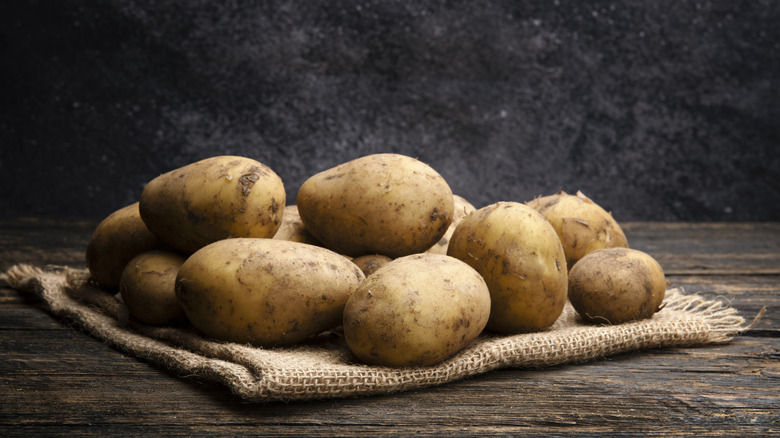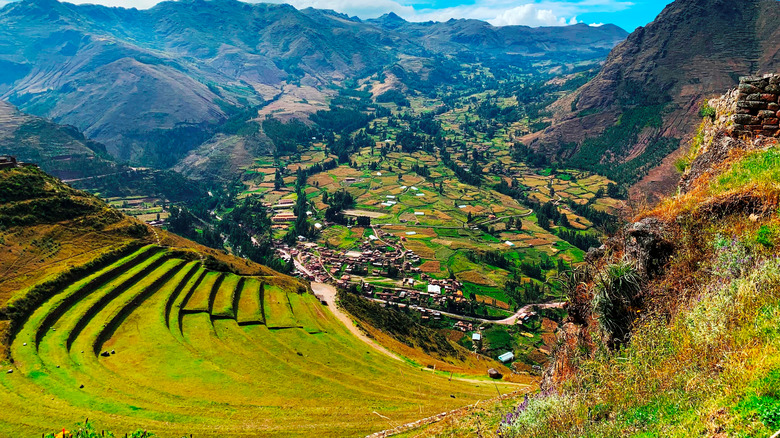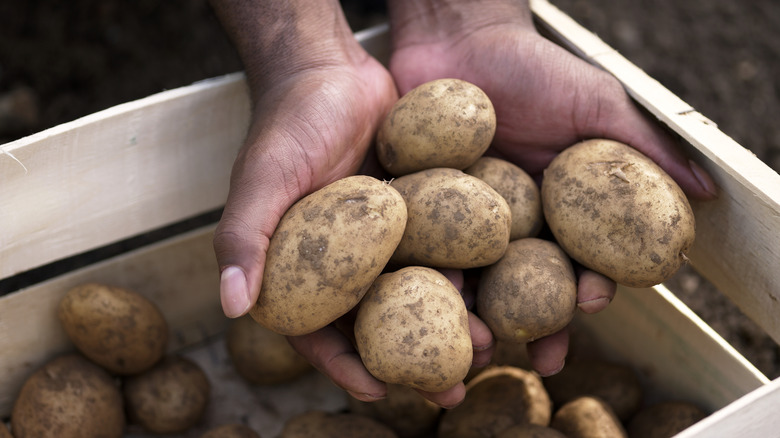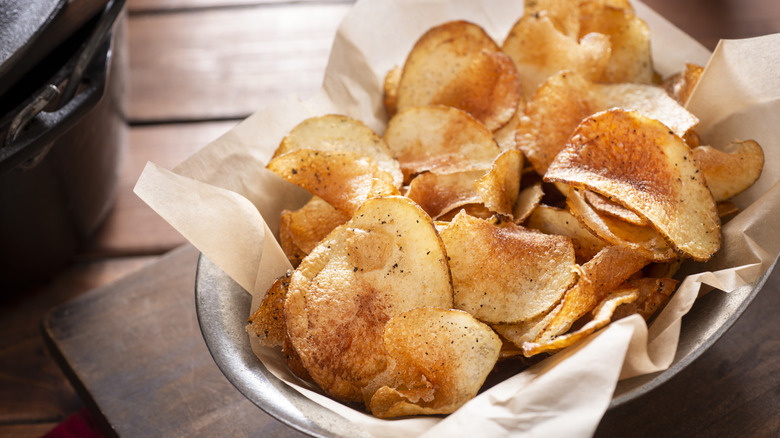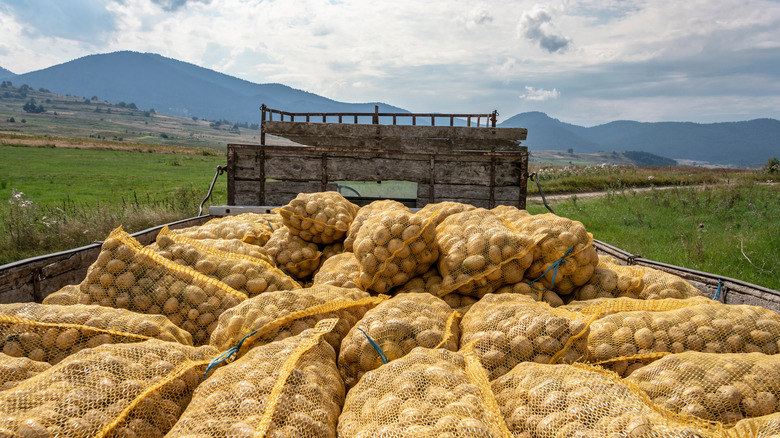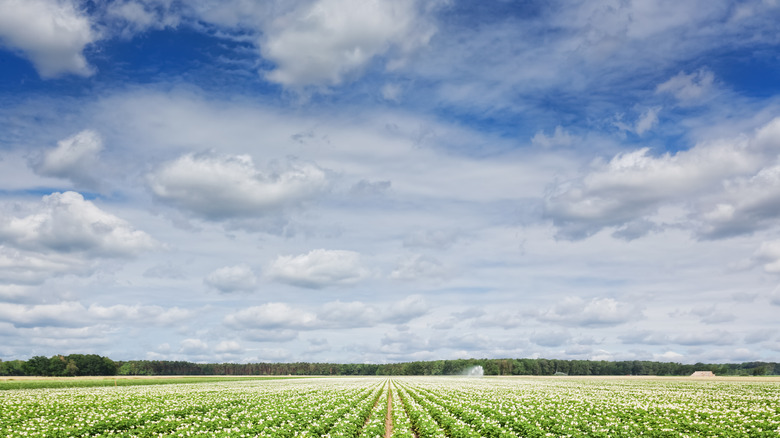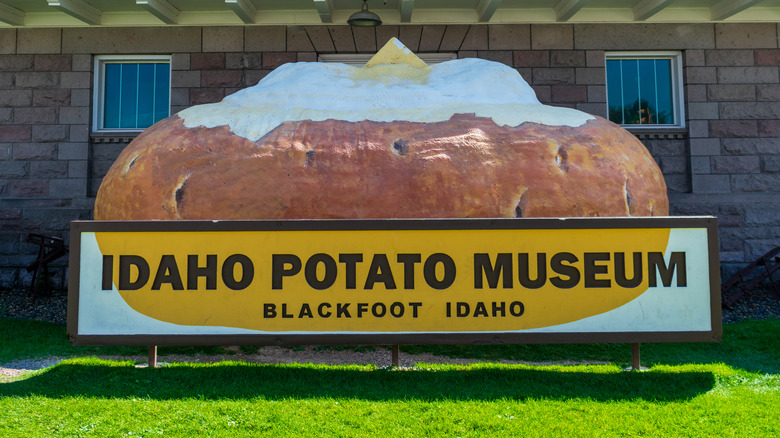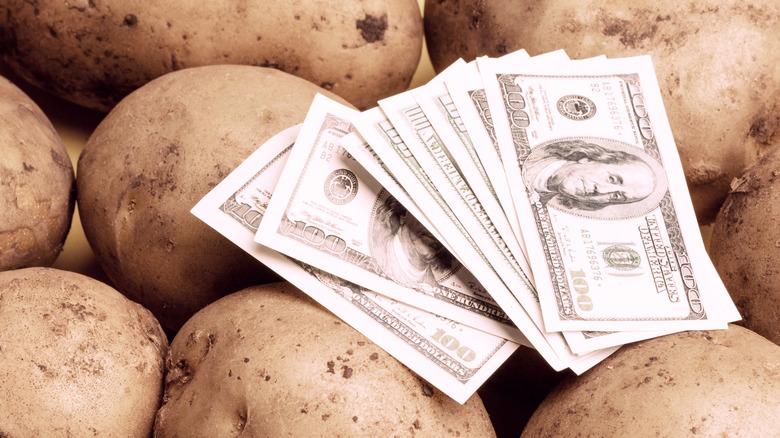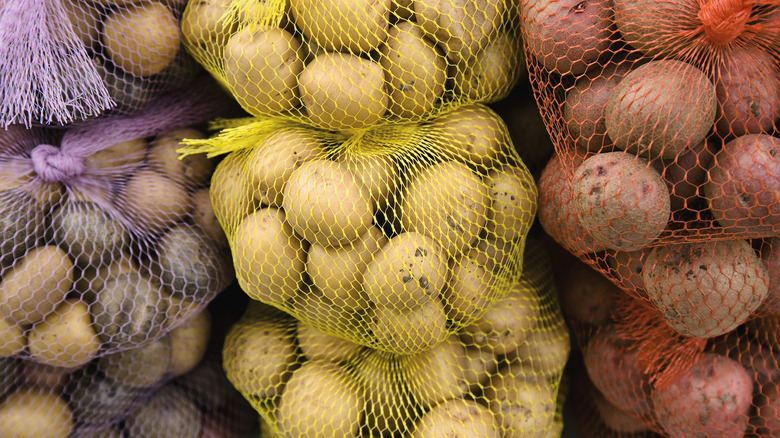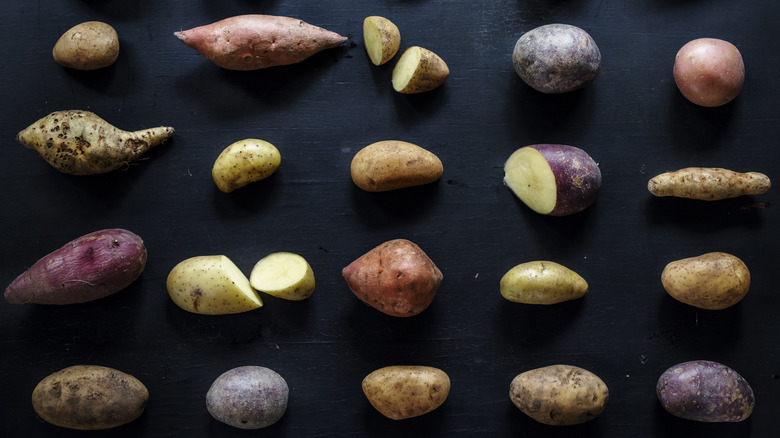10 Facts You Probably Didn't Know About Potatoes
Potatoes are such a common part of most daily diets that it's easy to take them for granted nowadays. The humble potato is a vegetable that's considered a staple food across most of the planet. In fact, it's the fourth-most cultivated crop in the world after rice, wheat, and corn, making it the most prevalent non-cereal crop we have.
Aside from being cheap and nutrient-dense, one of the main reasons potatoes are so popular is their versatility. You can add them to a stew, boil them in water, mash them, bake them, or turn them into crispy, golden fries. Many countries also boast famous traditional dishes that wouldn't be the same without potatoes, such as Canadian poutine, Dutch stamppot, Irish colcannon, and Polish pierogies.
The truth is that despite their prevalence and status as one of the most important vegetables in human history, there's more than meets the eye to potatoes. Subsequently, there are more than a few facts about them that may surprise you.
Potatoes came from South America
One of the most unusual facts about potatoes is that although they've been adopted by pretty much every country in the world, they have a single place of origin – the highlands of the Andes in western South America. In geographical terms, this region is part of what's now southern Peru and the northwestern tip of Bolivia. What's even more incredible is how long ago agricultural researchers believe people started growing potatoes in that region, which is sometime between 8,000 and 5,000 B.C. We know that potatoes didn't reach Europe until the 16th century, which means ancient Inca Indians could have been growing and eating them for nearly 10,000 years before they spread to the rest of the world. So, how did potatoes make their way to Europe?
By the 16th century, the Spanish weren't wasting time conquering much of South America, and by 1536, Spanish conquistadors had discovered potatoes and begun shipping them back to their homeland. However, despite some initial popularity in Spain, potatoes failed to catch on at first. Sir Walter Raleigh attempted to introduce them to the Irish in 1589, but it took another 40 years for the rest of Europe to take an interest.
Potatoes were likely introduced to North America in the 1620s when the governor of Virginia received a boxful as a gift from his counterpart in the Bahamas, but it still took until the 19th century for potatoes to become a staple in the region.
They last longer than you might think
While we should all be making sure we get enough fresh produce in our diets, the best stuff doesn't usually last long when there aren't preservatives involved, making it tricky to know just how much to buy without some careful meal planning before your grocery shop. Fortunately, this isn't something you really have to worry about when it comes to potatoes.
Potatoes can actually remain safe to eat for several months; however, there are a few rules to follow if you want them to stay fresh. First, they need to be stored in a cool, dark room like a pantry or kitchen cupboard. They also need to be kept well-ventilated so it's a good idea to store them in an open-topped bag or crate. If potatoes get too hot or wet, a few things can happen. They may simply start to rot — obviously less than ideal — or they could begin to sprout. Your potatoes might also turn green as a result of chlorophyll rising up under the skin which not only ruins the taste but may also make you sick, according to Healthline.
A common question is whether potatoes should be stored in the refrigerator, and the answer is — no, not unless they're already cooked. Cooked potatoes will remain safe to eat for around three days in the refrigerator, but storing raw potatoes in there will negatively impact their flavor and appearance as the drop in temperature causes the potato starches to break down into sugars.
Potatoes were once used as a medical cure
It's not really a big secret that potatoes are good for you. First, they're high in vitamin C which fulfills countless important functions, like helping with iron uptake, promoting tissue growth and repair, and working as an antioxidant. They're also an important source of vitamin B-6, which is important for brain development, and potassium, which does things like help our body regulate its fluids and blood levels.
However, historically, some people saw potatoes as having more specific healing powers and used the vegetables in numerous creative — if ineffective — ways. For example, while we're unsure of the precise origin of the remedy, the idea of putting slices of raw potatoes in one's socks to cure colds and other flu-like illnesses has been around for centuries. It's possible that the treatment came about while Europeans were battling the bubonic plague, long before modern germ theory was a thing. However, the same treatment has been suggested in traditional Chinese medicine, where it may have been intended to stimulate pressure points through reflexology.
Even today, alternative medical practitioners peddle pseudoscientific ideas that raw potatoes can draw out infections or relieve inflammation. However, one of the archaic treatments that may hold some weight is the idea that potato juice is helpful in treating stomach disorders, and while more research needs to be conducted, it does appear to relieve symptoms in those with chronic indigestion, according to a study done by Chrubasik S et al.
Nobody knows who invented the potato chip
While there are a handful of stories out there concerning the origin of the iconic snack, the reality is that nobody can really prove exactly where potato chips came from. The most common tale claims that potato chips were invented in 1853, in Saratoga, New York, completely by mistake.
The story goes that famous shipping magnate, Cornelius Vanderbilt, had stopped for a meal at a restaurant run by the famed chef, George Crum. After being served a plate of fried potatoes, Vanderbilt sent the meal back, complaining that they hadn't been sliced thinly enough. In a moment of malicious compliance, Crum sliced the next lot of potatoes as thin as possible before frying them, which Vanderbilt happened to love. However, Vanderbilt's biographer, T.J. Stiles, claims that even if this story were somewhat true, Vanderbilt played no part in it. It would also be odd that there's no record of Crum having invented potato chips, given he could be considered one of America's first celebrity chefs, and his other achievements are all well-documented.
It's also been claimed that Crum's sister invented potato chips because she accidentally dropped a thin slice of potato into hot oil while peeling them. The earliest recipe for potato chips came out of England in 1817, but there's still no hard evidence that the author invented them. The unfortunate truth is that we just have to be grateful potato chips exist, as it's unlikely we'll ever know who to thank.
You can grow potatoes at almost any altitude
As mentioned above, potatoes were first grown in the Andes mountains, which already tells us that they can be cultivated at extreme altitudes. These ancient potatoes were of a particularly hardy variety, growing at around 4000m in the South American highlands, but we've since discovered that potatoes tend to thrive at higher altitudes, according to a study done by Thomas T. Minda et al.
Potatoes can be grown at almost any elevation on Earth, depending on the time of year, which is something that's helped it reach its status as a staple global foodstuff. However, while potato plants are robust, they don't always thrive at lower altitudes. The issue isn't the elevation itself, but rather the fact that potatoes don't always do well in hotter and more humid environments thanks to potato blight.
You might be familiar with potato blight as one of the factors that led to the Great Irish Famine, which should tell you just how devastating it can be to potato crops. Also known as late blight, potato blight is a type of fungal disease that spreads through the leaves and tubers, causing rot and so rendering the vegetable completely inedible. Fortunately, nowadays we have potato varieties that are blight-resistant – either thanks to a natural immunity or a specifically-bred one — which means even more people have access to a low-cost, nutrient-dense staple food on which to survive.
Potatoes were the first vegetable grown in space
There are plenty of reasons we might want to study how vegetables grow in space, especially as humanity looks towards building bases on Mars and conducting multi-year cosmic voyages. In fact, we've been attempting to grow vegetables in space since 1995, and we started with potatoes.
While the Columbia space shuttle is now more infamous due to a flight that ended in tragedy, over the course of its lifetime it flew multiple scientific missions. As the shuttle was being prepared for its 19th flight, NASA began a collaboration with the University of Wisconsin to study how potatoes grow in a zero-gravity environment. If you're wondering why potatoes were the lucky candidates, we've actually already covered the two main factors. The stellar nutritional value of potatoes makes them a great candidate for astronaut food, and if they supported entire colonies on Earth, why couldn't they do the same in space? We also know that potatoes are extraordinarily tough when it comes to growing in harsh environments and at extreme altitudes, so they stand the best shot of successfully being cultivated somewhere as strange as a space shuttle.
The experiment didn't result in full-grown potatoes but it did create a foundation for today's results. Today's International Space Station astronauts can eat micro potatoes, called Quantum Tubers, that they grow in specialized computer-controlled growth chambers. This futuristic technology can even speed up the growth cycle of the tiny tubers, producing millions of them every year.
There's a potato museum
The USA was a relatively late adopter of the potato but is now the world's fourth largest potato producer after China, India, and Ukraine, according to the FAO (via Global Potato News). However, many people around the world still associate part of the country with potatoes. Specifically, if you were to ask most Americans which place made them think of potatoes, they'd tell you it's the state of Idaho.
It's true, Idaho produces a lot of potatoes. The Intermountain Western state is responsible for producing around 6 million metric tons of spuds annually, which puts it far ahead of Washington in the number two spot, as Statisa reports. While Idaho is officially known as The Gem State, you'd probably agree that it's earned its unofficial moniker: The Potato State.
Then, in 1988, a group of local potato industry figures finally succeeded in opening the Idaho Potato Museum in Blackfoot, situated in an old railway depot building that had been donated to the city. The museum's founders claim that the other members of the community didn't think the museum would attract visitors to Idaho, but it would appear the naysayers would eventually be proved wrong. Decades later, the museum is still going strong and features a Potato Lab, Potato Cinema, and showcases plenty of potato-related historical artifacts. There's also a café where you can order baked potatoes, waffle fries, tater tots, and potato soup. Well, what did you expect?
Potatoes were once used as currency
We've already mentioned how important potatoes were in various societies throughout history, but it may still surprise you to learn that at times they were exchanged as a form of currency. They were used as part of a bartering system before they even left South America.
In the Andes region, the Inca people of the 13th century didn't have a money-based economy and instead relied on a system of bartering and trade. At the time, potatoes held a lot of value because, aside from being a great food source, they were also used for medical treatments, and possibly to help with childbirth, predict the weather, and possibly even to measure time. As a result, potatoes would have likely been worth a good trade in the Incan economy.
Interestingly, there are still people today whose economy is still reliant on potatoes, although they don't have much choice. The archipelago of Tristan da Cunha, a British Overseas Territory, is the most remote inhabited island on Earth. It's so remote that it doesn't have an airstrip, and to get there, you need to take a six-day boat ride from Cape Town, South Africa. The population of roughly 250 people has an economy that's based on subsistence fishing and farming to make sure everyone is fed and their main staple food is — you guessed it — potatoes.
There are over 5,000 varieties of potato
You're probably aware that potatoes come in a wide range of varieties and can likely even name a good few of them like Yukon Gold, Russet, and Charlotte, but these are just the tip of the iceberg. Thanks to centuries of cultivation, there are now more than 5,000 different varieties of potatoes across the world.
You might think that sounds excessive, but there's a good reason for it. These varieties are all a result of potatoes' incredible adaptability and the fact that humans have carefully cultivated types based on their ability to thrive in varied climates and soil conditions, and at extreme elevations. Disease resistance is another quality that's been bred into some potato varieties which — as we mentioned previously — is a huge benefit in warmer areas of the world.
Potatoes can actually be reproduced in a couple of different ways. However, if we want a new genetic variety, we need to cross a male and female plant that has the characteristics we're looking for, then plant the seeds that come from female potato plants' flowers and berries. Each seed technically has its own individual genetic makeup, and from here it's possible to grow and test them to find out which ones we want to clone or crossbreed again.
It's important to choose the right potato for the job
There are reasons for developing new potato varieties that we didn't mention above, arguably just as important as the others. Many varieties were created specifically because of the way they taste, and to promote characteristics that might make them better when cooked in a specific way.
The simplest way to break down potato types is into three categories: starchy, waxy, and all-purpose. Unsurprisingly, starchy potatoes have a high starch content but also have a low moisture content. This makes them good at absorbing fat, so starchy potatoes like Russets and King Edwards are great for frying or baking. Conversely, starchy potatoes might fall apart when you boil them or use them in a stew.
Waxy potatoes like Nadine and Dutch Cream have a higher sugar content and lower starch content than starchy potatoes, so they hold their shape better and more suited for boiling and roasting, as well as adding to cold dishes like potato salads. They also have noticeably waxy skin which helps them keep their form. However, these properties mean they're not great for mashing, as they're harder to mush up, and you should avoid frying or baking them.
Finally, we have all-purpose potatoes, like Yukon Gold and Royal Blue, which can be used for almost anything, and while they may not be the best potato for a particular recipe, they'll probably still do the trick!

